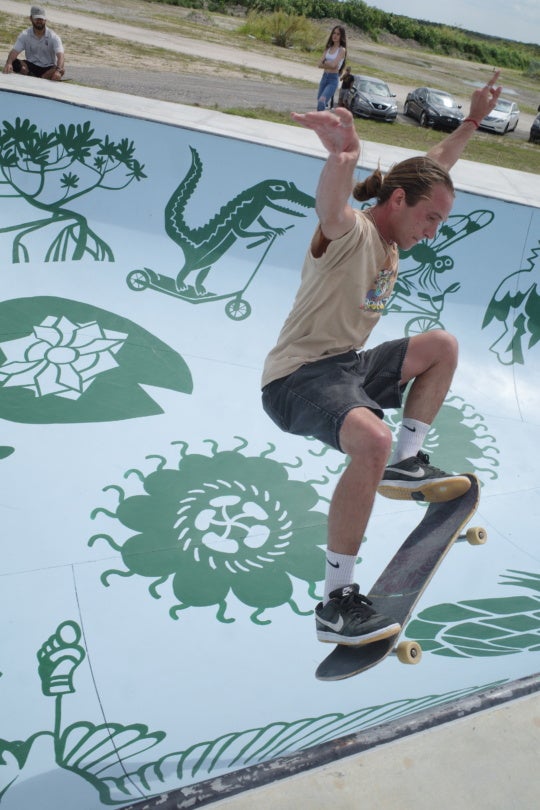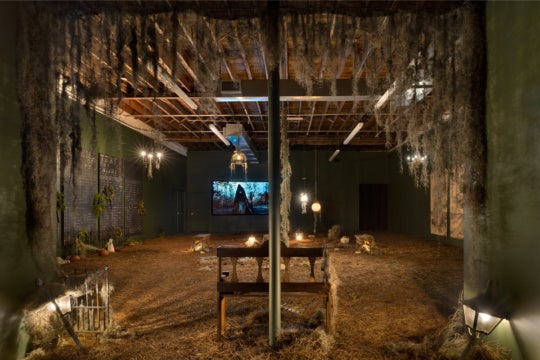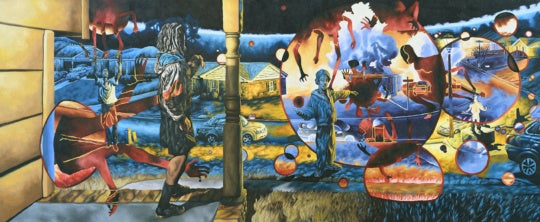
The idea for BURNAWAY originated from a front-porch conversation about the need for more dialogue about local art. Please welcome Joshua Rackliffe, director of programming for Living Walls, today’s guest writer of Our Front Porch and the author of the interview below.
Living Walls decided to interview Indigo, also known as Shallom Johnson, because of the impact she has been able to make on a global level with regard to public art. Similar to the mission of Living Walls, Indigo’s interest in art that exists in the public realm gives an additional perspective to how organizations and communities can strengthen one another. Within every group of people dwells the ability to offer sustainable progress through assembly, and the connections created through Indigo’s national and international artistic correspondence are admired by the Living Walls conference.

Joshua Rackliffe (JR): Can you give us a brief explanation of how you got involved with the arts—more specifically, maybe recall some events that led you toward artistic management and arts facilitation?
Indigo: Apologies in advance—it’s been a very indirect route to where I am now, and I’m no good at brevity. I got my first taste of arts management/event facilitation through my mom. She ran a dance studio in my hometown when I was growing up, so I was always involved in organizing recitals, as well as performing, and some teaching as I got older. Then, in university, I got involved in the administrative council for the Dance Student Union as well as taking on responsibilities for organizing shows, including the grad show for my graduating class in 2004. After graduation I formed a collective called 30Toes with three friends from school, and we continued self-producing shows in and around Vancouver. At the same time I was also balancing part-time jobs as a community dance instructor and an administrative secretary while freelancing as a fashion and arts writer for print and online media. In 2007 I traveled to Washington D.C. for a four-month apprenticeship with the Liz Lerman Dance Exchange, in which I had the opportunity to get even more of a sense of what was possible with community-based, participatory arts projects involving multiple disciplines.
In 2008 we disbanded 30Toes (it was, at the time, supposed to be just a break but ended up … permanent …), and we all went our separate ways. I had just started experimenting with stencils and spray-paint and putting up work in the street—working with a new medium was exciting for me, and I wanted to see where it could go with a more focused approach. I’ve always been painting and drawing (my initial intention was to enroll in the Visual Arts program at [Simon Fraser University in Burnaby, British Columbia, Canada], but after a year I switched majors). I had spent the last eight years feeling like a dancer who liked to paint.
While I was spending my nights running around the city with stencils and paint and, later on, stenciled wheat pastes, I was getting more involved with the fashion industry, producing small- and large-scale events in Vancouver, providing consultation and PR/marketing support, editing what was at the time one of Vancouver’s top three fashion blogs, traveling to cover shows in other cities, and interviewing influential designers and artists for multiple publications. Through all of this I was getting more and more interested in what I was doing with stencils and street art, and after a while the superficiality of the fashion scene wore me out. I curated my first group exhibit in Vancouver in spring 2009, started traveling to paint that summer, [and] quit my secretarial day job a few months later to be a full-time artist.
In 2010 it really felt like someone pressed fast-forward on my life as a visual artist, and I was just running to keep up. It was a difficult year, and I was really hungry for most of it, spending all of my money on paint and all of my time cutting holes in plastic film—but I learned a lot, was able to travel a lot, and began to form a network of creatives that has continued to grow and has proved essential to what I am doing today. In 2011, I was able to spread my curatorial wings a little further, curating and producing two large mural projects and three exhibits in Vancouver. And now I’ve relocated to Cape Town [South Africa], and all of the puzzle pieces from the last 10 years of my life are finally starting to fall into place within one practice.
JR: What are you working on in South Africa? Please briefly explain your role with AWOA [A Word of Art].
Indigo: I’m directing the international residency program and the gallery/project space, and am involved in curating/producing community arts projects as well. I live in the residence with all of the visiting artists and work with each of them individually to realize their artistic vision.
JR: What served as the liaison from performer to public artist? Would you consider the act of public art a performance itself?
Indigo: Making the switch away from movement-based creation into the visual arts was a challenge, but [it] seemed relevant. I’d been doing a lot of site-specific choreography and performance in public spaces, and so transitioning to playing with static visual images in public space made a lot of sense.
I think that everything in life has an aspect of performativity. The creation and curation of our identities as artists is a performance in and of itself. Creative interactions with the urban landscape pull other people into the performance, regardless of whether … they are aware [of being a part of it]. Within the making and the viewing, the cycle of painting and pasting and buffing and layering of text, color and images, sometimes it all seems like a massive interactive performance that is playing out on a hyperlocal and global scale. A shared experience of becoming.
JR: As a visual artist, what is the imagery you work with [responding] to?
Indigo: I am most drawn to and inspired by people, their strengths and weaknesses, and how their physicality reflects their individual and shared experiences, memories, hopes and dreams and fears.
JR: Your art has reached people on a global level. What do you find is consistent between most art communities, and what are some examples of cities that seem to have a better understanding of the way public space/urban living/dense communities [are] affected via art?
Indigo: I’m not sure if I can answer this one properly yet, I haven’t done enough exploring. There are too many variables.

JR: How do your gender, race, and class serve as distinctions for the type of art you are compelled to create? Has that changed … or become expanded because of your experience?
Indigo: I am always influenced by my surroundings, my present and past experiences. I feel most at home living within poor urban communities. There is more heart, life is more visceral. Things are more rough around the edges, more honest. People are fucked up, we are all fucked up, and within these spaces nobody feels the need to hide it. I am interested in creating artwork for and with people who cannot afford to participate in the art industry. It is what I have to give back; the best way that I know to make a difference.
JR: What advice would you give to young artists and arts organizers who seek to [have an impact on] their communities [or] impact global communities?
Indigo: The most important thing is kindness, in all things. In order to be kind, you must listen before speaking, think before doing, move through the world with open eyes, open hands, open heart. In order to create change, we must seek it first within ourselves.
JR: How did the extreme transition of moving from Canada to South Africa influence your foundations of arts management?
Indigo: I think that my initial trip to Cape Town expanded my vision of what was possible. Now that I’m back, it’s a process of listening and learning in this new environment, so that I can dream big. Acting with consciousness, courage, and respect.

JR: In a hyper-globalized and technologically dependent society, how can one get a clear scope of what qualifies as contemporary art? Where are the promising domain changers of contemporary art when ideas are constantly appropriated for brief, individual gain?
Indigo: Honestly, at this present moment I no longer care what qualifies as contemporary art. I am interested in making and doing. I think that as artists we need to create what feels authentic and feels right to our individual and collective ethos, without worrying too much about whether it conforms to any particular external label or category.
JR: What’s in store for the AWOA program in South Africa? How can the goals and challenges you grapple serve as guidelines for like-minded people in other parts of the world who might not have thought they were capable of creating a community such as this?
Indigo: We are building bridges across the world and back again, sharing dreams and experiences with painters, writers, photographers, musicians, curators, creative activists, and [others]. We are also building our ship at the same time as we are attempting to sail it. This program is still going through growing pains, and we are learning and adjusting every day. It’s a hell of a lot of hard work, but our vision is strong. I think the next six months will be instrumental in establishing the foundation for the program and the organization to grow, nurturing and nurtured by the community, without which it cannot survive.
Please feel free to participate in the open comments underneath this article, or share it elsewhere and discuss informally with your friends. Talking in person counts!
Our Front Porch is a series inviting guest contributors to share thoughts on contemporary art for open discussion with you, our readers




